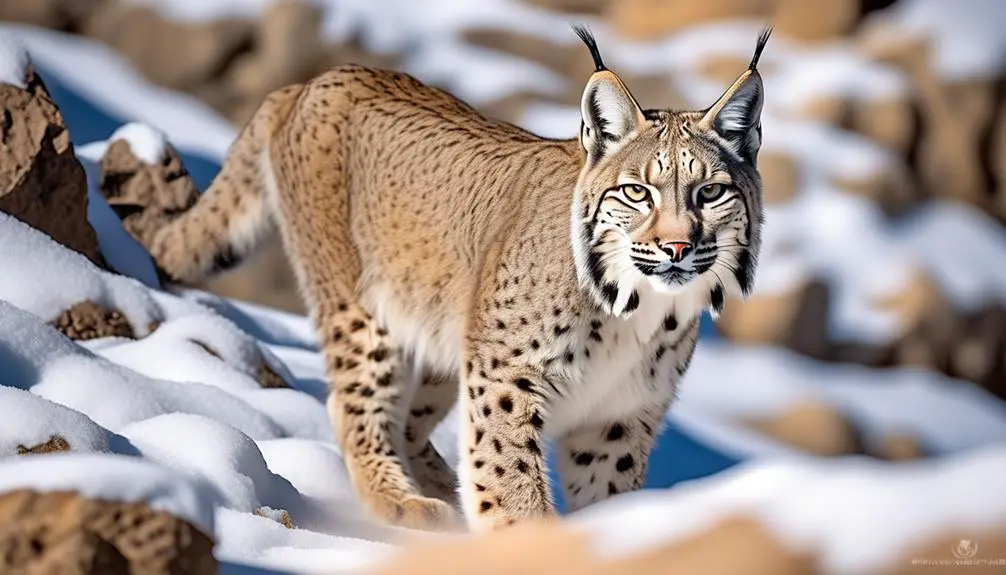Did you know that the picturesque state of Colorado is home to not one, not two, but three captivating species of wild cats? These magnificent creatures, with their stealth and beauty, are a testament to the thriving biodiversity of this region.
From the mysterious mountain lion to the elusive bobcat and the endangered lynx, each cat has its own story to tell. But what sets them apart? And where can you catch a glimpse of these elusive felines?
Join us as we unravel the secrets of Colorado’s wild cats, revealing their unique characteristics, habitats, and the challenges they face. Prepare to be amazed as we take you on an unforgettable journey into the untamed wilderness of Colorado.
Mountain Lion in Colorado
The mountain lion, also known as the cougar or puma, is a large and powerful wild cat species found in the remote areas of Colorado. These majestic creatures can reach sizes of 7-8 feet in length and weigh between 90-150 pounds. Their diet mainly consists of deer, elk, porcupines, small mammals, and occasionally livestock. Mountain lions prefer habitats with adequate cover and plentiful deer, often found in areas with pinyon pine, ponderosa pine, mountain mahogany, juniper, and oak brush.
In Colorado, the population of mountain lions is estimated to be between 3,000 to 7,000. It’s important to note that these wild cats are active during dawn, dusk, and nighttime. For the safety of your pets, it’s advisable to spend time outside with them during daylight hours and be cautious or avoid long walks during the active times of mountain lions.
To further ensure the safety of your pets, it’s recommended to keep them on a leash or tie-out. Additionally, removing food sources such as storing trash cans inside a garage or shed, not leaving food outside, and bringing domesticated chickens inside at night can discourage wild cats from visiting residential areas.
If you encounter a mountain lion, it’s crucial to make noise, yell, clap your hands, or use an air horn to scare them away. Remember, appreciating these wild cats from afar is the safest approach, as mountain lions are dangerous wild animals and shouldn’t be approached or interacted with.
Bobcat in Colorado
Bobcats, one of the types of wild cats found in Colorado, roam the state in significant numbers. These elusive creatures have adapted well to the diverse landscapes of Colorado, from the grasslands to the mountains. Here is some essential information about bobcats in Colorado:
| Size | Weight | Diet | Physical Features | Population |
|---|---|---|---|---|
| 3 feet | 8-40 lbs | Rabbits, birds, rodents | Twice the size of a house cat, with distinct markings | Estimated 12,000 |
Bobcats are about three feet long and weigh between 8 to 40 pounds. They primarily feed on rabbits, birds, and rodents. Bobcats are known for their distinctive physical features, including their size, which is twice that of a typical house cat. They have a six-inch tail with a white tip underneath and a black spot on top. These markings help differentiate them from other wild cats in Colorado.
With an estimated population of 12,000, bobcats are more commonly encountered than their larger counterparts, the mountain lions and lynx. While they are generally shy and elusive, bobcats can occasionally be seen near residential areas. It is important to remember that bobcats are wild animals and should not be approached or interacted with.
To coexist safely with bobcats and protect your pets, it is recommended to follow safety measures such as keeping pets on a leash or tie-out, removing food sources, clearing away thick brush, and scaring away any wild cats you encounter. By understanding their behavior and taking necessary precautions, you can help ensure the well-being of both bobcats and domesticated animals in Colorado.
Lynx in Colorado
With an estimated population of 150-250 in Colorado, the lynx is a fascinating and endangered species of wild cat found in the state.
The lynx, scientifically known as Lynx canadensis, is known for its distinctive physical features and hunting abilities. They’ve a size of approximately 3 feet and weigh between 16-30 pounds. One of the most notable characteristics of the lynx is its massive feet, which are out of proportion with their body. This adaptation allows them to navigate and move easily through deep snow, their preferred habitat.
The lynx primarily feeds on snowshoe hares, squirrels, voles, grouse, and porcupines. However, their survival is closely tied to the abundance of snowshoe hares, which make up a significant portion of their diet.
Due to habitat loss, climate change, and other factors, the lynx has become endangered in Colorado. Efforts have been made to reintroduce lynx in the late 1990s, but their population remains small.
It’s crucial to appreciate and protect these majestic creatures from a distance, as they’re an integral part of Colorado’s unique wildlife ecosystem.
Conclusion
In conclusion, Colorado is home to three remarkable species of wild cats: the mountain lion, bobcat, and lynx. Each species possesses its own unique characteristics and behaviors, adapting to the diverse landscapes of the state.
By understanding their physical features, habitats, diets, and population estimates, we can appreciate the importance of conserving these magnificent creatures.
Additionally, as responsible pet owners, implementing safety measures can ensure the well-being of our beloved pets when encountering wild cats in their natural habitats.

Erzsebet Frey (Eli Frey) is an ecologist and online entrepreneur with a Master of Science in Ecology from the University of Belgrade. Originally from Serbia, she has lived in Sri Lanka since 2017. Eli has worked internationally in countries like Oman, Brazil, Germany, and Sri Lanka. In 2018, she expanded into SEO and blogging, completing courses from UC Davis and Edinburgh. Eli has founded multiple websites focused on biology, ecology, environmental science, sustainable and simple living, and outdoor activities. She enjoys creating nature and simple living videos on YouTube and participates in speleology, diving, and hiking.

